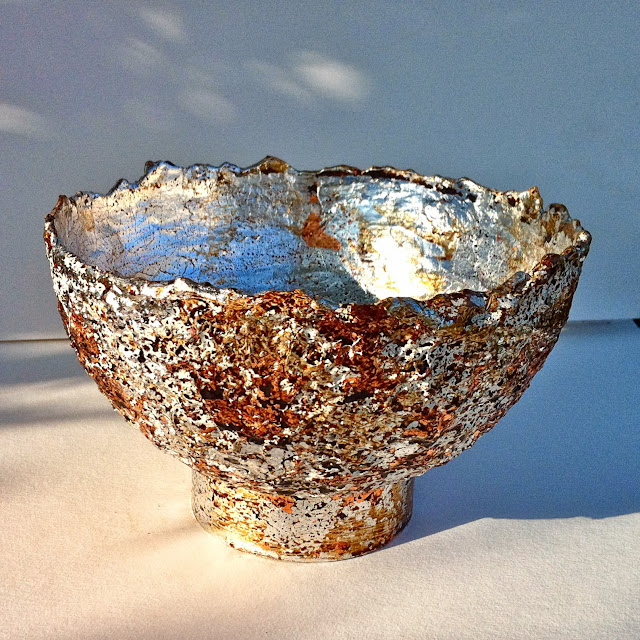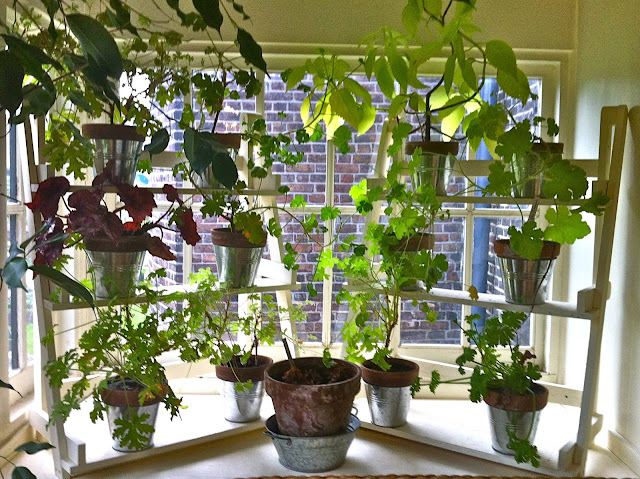Collect together the following items
Terracotta flower pot - This is only intended to give support to the bowl whilst it is being constructed. The size of the pot will depend on how large you want your bowl to be. Terracotta is good as it gives weight and helps to keep the process stable. Initially, work on a small bowl to practice - small flowerpot/small balloon.
A few round balloons - extra in case some burst!
String + masking tape
Box of tissue/roll of loo paper - it absorbs lots of glue + is good for the first layers - though not essential - most papers will do.
Newsprint - tissue paper, brown wrapping paper or newspaper will also be fine.
Thick paper = card is good too.
2 bowls + sieve + white glue + brush + blender.
The colour of the balloon I am working on changes throughout these sequences as balloons do deflate! It's a simple matter to remove it and blow up another inside your partly made bowl. Really!
First step - secure your balloon.I soak the paper - newsprint, brown paper, tissue etc and then let it drip to almost dry. This makes the paper almost like fabric - flexible and easier to manipulate, tear and paste.
Repeat by adding more layers of glue and paper and allow to dry. How many layer you add really depends on the size of the balloon your working on. The bigger the balloon and therefore the bowl - the more layers. I add about 4- 5 layers when using this method. The pulp adds most of the strength to the bowl when dry.
In this method I am ripping up watercolour paper into small pieces to put in a blender to make papier mache pulp. Any paper will do.
I add warm water to help soften the paper and then whizz it all up until there are no lumps and sieve it, gently pressing about 80% of the water out. I try to avoid squeezing and making lumps!
Then I add the glue. I'm using white glue. In the U.K we call it P.V.A glue - in the U.S.A it's generally called Elmers glue. I have other recipes on my blog using flour and water paste. I do like using flour and water paste as it makes the work much more brittle. P.V.A glue brings in a little flexibility to the work which can be an advantage. The amount of glue you add depends on the amount and type of paper you are using. It's all a matter of experimentation really.
Mix it all up and then leave it on one side to absorb for a few minutes.
Add pulp in small amounts - working from top to bottom - gently pressing and smoothing out. It helps to work with wet hands - have a small bowl of water by you to dip fingers in. If the pulp should start to slip down the sides of the bowl as you are working with it, simply stop and leave it to dry and then continue later, filling in the gaps. It all works out in the end!
I have used the inner cardboard disc of an old masking tape roll to make an indentation into the top of the soft pulp which I then filled with glue and pressed the disc into. This will make the foot of the bowl.
When it is dry - pop the ballon. Notice yet another coloured balloon! Remove balloon by popping it.
Trim away excess to make your bowl the height you want it to be.
I am gently ripping away some more dried pulp as I want to create a deckle edge.
I am making traditional gesso with rabbit skin glue, ground chalk (whiting) and water. It is made in a double boiler as it is a gentle process. You can use acrylic gesso.
Recipes for traditional gesso and homemade alternative gesso can be found by clicking the links.
Painting on coats of warm traditional gesso. Leave to dry between coats. If you build up many coats of gesso you can burnish it to a smooth finish and/or scratch surface decoration into it. I have just painted the inner part of the bowl with gesso and will add silver leaf. I want to create an aged patina to the silver so when the whole bowl is finished I will let it spent a couple of days in a cardboard box with a couple of hard boiled eggs. The result, although temporarily rather smelly is well worth it!
I am always looking for inspiration. This is a discarded piece of lead flashing in an old bucket but once edited in photoshop looks like this -
And gives me the idea for a starting point for developing the outer surface of the bowl with fragments of gold, copper and silver leaf, acrylic inks - F.W and Pearlescent, iridescent tinting medium and gesso. - Will post as soon as it's done!
I have painted the outer surface of the bowl with acrylic gesso and added silver and copper leaf by 2 steps -
First of all I painted the inside of the bowl with some Acrylic Gold Size and quickly painted random areas of the outside of the bowl with it too, using an old brush. It only takes a few minutes to go tacky and then I added the silver leaf by gently pressing it against the tacky surface. I brushed away any excess with a soft, dry brush (saving any little flakes for future projects) and then repeated the process on the inner part of the bowl to ensure it was pretty well all covered with silver leaf.
N.B. - Acrylic Gold Size is not generally used on top of traditional gesso as it tends to form a skin which peels off. I have been using it this way for years and just work with it and if bits peel away, then I simply re-apply the size and some more silver leaf. This is because I will eventually be polishing it with beeswax or Renaissance wax polish and it will be fine. If you are using acrylic gesso there will be no little anomalies. I rather like the serendipity of anomalies as it usually leads to new discoveries.
I then repeated the process adding gold leaf.
Next I added
Source: cornelissen.com via Hilary on Pinterest
Then I added very loose layers of thick white acrylic paint and leave to dry.
The next photos will show the addition of coloured acrylic paint and then a mixture of flakes of dyed metal leaf -
I have used a couple of different gesso methods in this tutorial but you can choose which one you use. The links to products and suppliers are merely suggestions, not directions. There are many suppliers and producers all doing similar things.






































































